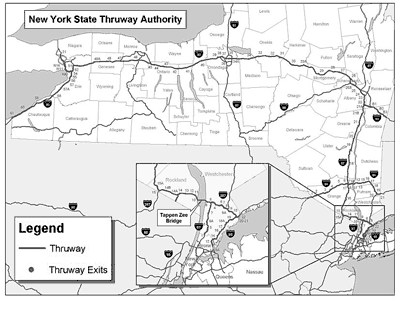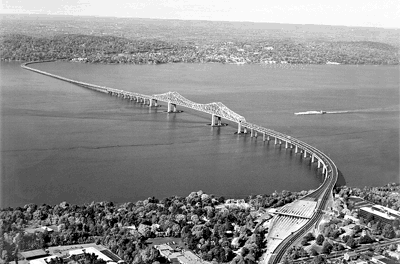| << Previous | Contents | Next >> |
ACTT Workshop: New York
Tappan Zee Bridge Deck Replacement
[Archived] Chapter 2: Project Details
2.1 Corridor Description
The 3.1-mile Governor Malcolm Wilson Tappan Zee Bridge carries the New York State Thruway (I-87 & I-287) over the Hudson River between Rockland and Westchester counties, providing a lifeline between New York City and Upstate New York. (See Figure 1 below.)

One of the longest bridges in the United States, the Tappan Zee opened on December 15, 1955, at a cost of $80.8 million. Currently more than 132,000 vehicles cross the Tappan Zee Bridge every day, with traffic volumes reaching as high as 165,000. When the bridge opened in 1955, it carried an average of 18,000 vehicles a day.
The bridge features three dedicated northbound and three dedicated southbound lanes. A reversible lane located along the center of the bridge provides a total of seven lanes. The structure consists of 198 spans divided into five distinct sections:
- West causeway (spans 1-166).
- West deck truss (spans 167-173).
- Main spans (spans 174-178).
- East deck truss (spans 179-191).
- East causeway (spans 192-198).
A 69-member crew, headed by a professional engineer, performs the daily work necessary to keep the bridge functioning smoothly. The Thruway's "navy" includes two tugboats, two workboats and four barges that facilitate inspection and maintenance.
Conditions and Needs
Over the years, the Tappan Zee Bridge has undergone periodic maintenance to address structural deck and steel wear. Recent inspections and an increasing number of emergency repairs indicate that the superstructure elements from spans 1 through 178 (structural deck, fascia structural steel and cantilevered walkway) have approached the end of their service life.
Using the rating system shown in Table 1, the firm of Ove Arup & Partners inspected the Tappan Zee Bridge in 2002 and 2003. They gave the bridge an overall rating of 4, which indicates significant areas of deterioration. The report states, "primary areas of deterioration on the bridge were found to be concentrated on the bridge deck and safety walk throughout all the spans."
| Rating | Description |
|---|---|
| 1 | Potentially hazardous. |
| 2 | Used to shade between a rating of 1 and 3. |
| 3 | Seriously deteriorating, or not functioning as originally designed. |
| 4 | Used to shade between a rating of 3 and 5. |
| 5 | Showing minor deterioration; is functioning as originally designed. |
| 6 | Used to shade between a rating of 5 and 7. |
| 7 | Exhibiting like-new condition. |
| Location | Condition Rating |
|---|---|
| West Causeway Deck (spans 1-166) | 3.0 |
| West Truss Deck (spans 167-172) | 2.6 |
| Main Span Deck (spans 173-178) | 3.0 |
Ground penetrating radar (GPR) and underdeck soundings performed in 2002 indicate that approximately 475,000 square feet of the 1,075,000 square feet (spans 1 through 178) have been denoted as deficient, which means they show imminent spalling or are hollow sounding. Additionally, a minimum of 960 potential punch throughs have been identified, with 46 percent located in the outboard lanes, lanes one and seven, and the next highest level of potential failures, 26 percent, located in lanes two and six.
The Thruway Authority's maintenance records show that crews repaired 29 punch throughs in 2002, 55 in 2003 and 66 in 2004. Each repair averaged approximately nine square feet in size and took anywhere from four to eight hours to complete, significantly reducing the level of service provided during each repair.
The concrete walkway and structural steel exhibit significant deterioration as well. The 2002 inspection report rated the existing concrete walkway a two, stating that the section is in a "serious state of deterioration," with approximately 80 percent of the concrete walkway in need of repair.
Likewise, the degree of deterioration on 63 percent of the cantilevered steel is considered severe, with significant section loss in the exterior bays occurring because of deck runoff from the open drainage system. This type of drainage system allows water containing chlorides from deicers to flow from the roadway surface down onto the structural steel. The existing roadway lighting and associated wiring components located on the cantilevered section have undergone regular maintenance due to deterioration of the electrical system consistent with the issues noted above.
2.2 Project Goals and Objectives
The State of New York is conducting an environmental study for the entire I-87/I-287 corridor. Pending the results of that study, the Thruway Authority has an urgent need to address existing bridge deficiencies on the Tappan Zee. In order to do that, the Thruway Authority has noted the following objectives:
- The alternative selected shall be prioritized to address the areas determined to need immediate treatment, considering the construction timeframes, associated repair costs and the provided service life. The selected repair alternative must complement the proposed alternatives under consideration in the corridor study.
- The alternative selected shall consider the salvage capabilities dependent on the corridor study results.
The Thruway Authority is also seeking to employ the philosophy of the FHWA Highways for LIFE (Long lasting highways using Innovative technologies and practices to accomplish Fast construction of Efficient and safe pavements and bridges) initiative. The FHWA initiative targets certain goals:
- Improve safety through reduced exposure due to shorter construction windows; inclusion of improved safety features; and, with quicker project delivery, a reduced period of potential construction-related accidents.
- Reduce work zone congestion by combining shorter construction windows with the latest work zone management/communication technologies. Reduced congestion lowers user delay costs and environmental impacts (both noise and air).
- Improve quality by delivering a final product representing the best that the industry can produce.
Further, the Thruway Authority is looking to utilize nighttime construction to minimize user delays. By utilizing the work zone technology noted above, the Thruway Authority plans to keep traffic impacts at a minimum during the nighttime construction window.
Other project goals are as follows:
- Significantly reduce maintenance activity on the superstructure from spans 1 through 178. This will minimize the frequency of user delays and the resulting lower levels of service during repair cycles.
- Provide a minimum 15-year service life that will address the existing superstructure and safety walk deficiencies; improve element-specific bridge condition ratings; and minimize the life cycle cost of maintenance and repair.

2.3 Recommended Alternative
Prior to the start of the workshop, the Tappan Zee Bridge Repair Project Team had identified what it felt was the only realistic alternative for meeting the goals described above: remove the existing bridge superstructure (deck and steel girders), along with the cantilevered fascia section, from spans 1 through 178 and install a new superstructure.
The new structure would consist of a prefabricated superstructure system with upgraded roadway lighting, associated electrical work, bridge railing system, drainage system and associated substructure modifications. As detailed, the work would be let in three successive construction contracts.
Contract #1:
Remove the existing deck and support steel in lanes one, two, six and seven and the cantilevered walkway from spans 1 through 178. Install the prefabricated superstructure system. Replace the bridge rail and roadway lighting. Perform substructure repairs in affected areas.
Contract #2:
Remove the existing deck and support steel in lanes three through five from spans 167 through 178. Install the prefabricated superstructure system. Perform substructure repairs in affected areas.
Contract #3:
Remove the existing deck and support steel in lanes three through five from spans 81 through 166. Install the prefabricated superstructure system. In lanes through five, remove the remaining original superstructure up to the prefabricated median superstructure (contract TANY 96-1B) from spans 1 through 81. Perform substructure repairs in affected areas.
The estimated project timeframes are as follows:
Contract #1:
This project is scheduled to be let in 2005, with construction scheduled to take place from 2006 through 2008. The project will be funded completely with Thruway funds.
Contract #2:
This project is scheduled to be let in 2008, with construction slated to occur in 2009 and 2010. Funding sources are still to be determined.
Contract #3:
This project is scheduled to be let in 2010, with construction tentatively scheduled for 2011 and 2012. Funding sources are yet to be determined.
| << Previous | Contents | Next >> |

